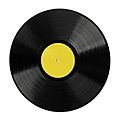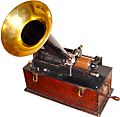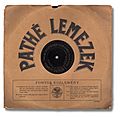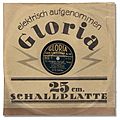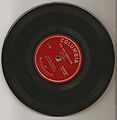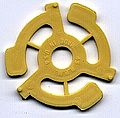Gramophone record facts for kids
A gramophone record, often just called a record or vinyl record, is a flat, round disc. It stores music and other sounds. Records were very popular for playing music throughout most of the 1900s. You play them on a machine called a phonograph, also known as a record player.
Records are usually made of plastic. They have a tiny, wiggly line called a groove. This groove spirals from the outside edge of the record all the way to the middle. When you play a record, a small needle on the record player follows this groove. This makes the sound come out! Most records have different music on each side.
Contents
The History of Records
The idea of recording sound started a long time ago.
Early Inventions
Thomas Edison created the first phonographs in the 1870s. His very first recordings were made on tin foil. Soon after, people started using wax cylinders instead. These cylinders were better because you could remove them from the machine and play them again. The sound wouldn't be ruined.
Discs Become Popular
Even though disc records were made as early as 1888, they didn't become more popular than cylinders until 1902. The first discs were made from a material called shellac. Later, they were made from polyvinyl chloride, which is often called "vinyl."
Types of Records Over Time
Records came in different sizes and could hold different amounts of music:
- Singles usually had just one or two songs.
- EPs (Extended Play records) held about three to five songs.
- Albums had many more songs, often a dozen. They could play for 30 to 45 minutes.
These names for music formats are still used today, even for digital recordings. Modern digital singles and albums can hold much more music.
The Comeback of Vinyl Records
Vinyl records became less popular for a while. This happened when new formats like cassette tapes and then CDs came out. However, they never completely stopped being made.
In recent years, vinyl records have become popular again! While many CD shops have closed, more and more shops that only sell vinyl records are opening. Many music fans believe that vinyl records offer a higher sound quality compared to newer digital formats.
Images for kids
-
A typical 12-inch LP record
-
Edison wax cylinder phonograph c. 1899
-
Emile Berliner with disc record gramophone
-
A multinational product: an operatic duet sung by Enrico Caruso and Antonio Scotti, recorded in the US in 1906 by the Victor Talking Machine Company, manufactured c. 1908 in Hanover, Germany, for the Gramophone Company, Victor's affiliate in England
-
Boston Pops conductor Arthur Fiedler demonstrating the new RCA Victor 45 rpm player and record in February 1949
-
Columbia and RCA Victor's competition extended to equipment. Some turntables included spindle size adapters, but other turntables required snap-in inserts like this one to adapt Victor's larger 45 rpm spindle size to the smaller spindle size available on nearly all turntables. Shown is one popular design in use for many years.
-
A DJ mixing vinyl records with a DJ mixer at the Sundance Film Festival in 2003
See also
 In Spanish: Disco fonográfico para niños
In Spanish: Disco fonográfico para niños




